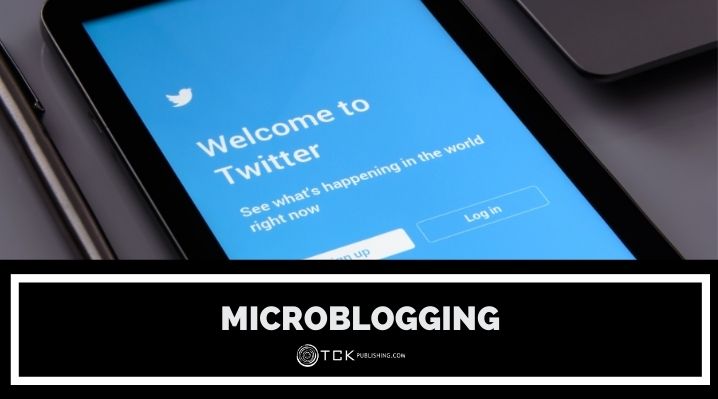
In this digital landscape, blogs have become the staple of internet reading. But as this space continues to evolve, there seems to be a clear trend towards shorter blog content.
This is where microblogging comes in. While long-form content still produces much value, people’s preference for short-form content has made this new type of blog format necessary.
What is Microblogging?
Microblogging is the act of creating concise posts that are, on average, 300 words or less. It’s a combination of instant messaging and content creation, where you create short messages that can be posted and shared with anyone online.
These messages are called microblogs, and are designed to be quick, direct and are published on microblogging platforms like Twitter and Tumblr. In addition to text, microblogs can include links, images, audio, and video.
The main difference between microblogging and traditional blogging is length. Traditional blogs range from a couple of paragraphs to multiple pages of long-form content. Microblogs, on the other hand, rarely go beyond a paragraph.
Here is a quick and dirty guide to their differences:
| Blog | Microblog |
| Long entries | Shorter posts |
| Written in article format | Written in short text that resemble headlines or summaries |
| Longer time in between posts | Frequent posts; usually multiple times a day |
| Usually with its own website | Hosted in social media platforms |
| You own the blog and its content | Platforms usually own the microblog and content |
Pros and Cons
Here are some advantages and disadvantages of microblogging.
Pros
- Conciseness—Microblogging is a fast way to disseminate information, especially when it comes to important and time-sensitive news.
- Simplicity—Microblogging platforms are relatively straightforward to use, making it easy for you to create and share content. Not much technical expertise is needed, unless you’re checking for SEO and other metrics.
- Social Engagement—Microblogs are an easy way to start conversations and engage with your audience through comments, shares, and likes. Even posting a simple poll can bring in tons of reactions.
- Real-Time Updates—Microblogs allow for instant dissemination of information, enabling you to keep your audience up to date with the latest news as they unfold.
- Portability—You can create, view, and post microblogs practically anywhere as long as you have access to the internet.
- Marketing Funnel—Because they are brief, microblogs only contain essential information. You can use them to make your audience curious and funnel them toward your long-form content by adding links and call-to-actions.
Cons
- Lack of Depth—Because of its brevity, microblogging sometimes makes it difficult to convey complex information. This can lead to thin content—information that has little to no value to a user.
- Misinformation—Because of lack of depth, a microblog can be easily misunderstood and be the catalyst for false information. This is why microbloggers must be careful in crafting their messages to be effective.
- Easy to Bury—With the high volume of microblogs being made and shared every day, people can be overloaded with content. Unless it goes viral, the post you made could be easily buried by a constant stream of information.
- SEO Limitations—There are not a lot of keywords and backlinks you can fit into a short post. The fragmentation of posts due to platform limits also makes it challenging for search engines to make sense of your content.
Microblogging Platforms
Microblogs can be done on any platform suitable for your goals. However, most microblogging tends to happen on platforms specifically designed for it. Here are some of the most popular microblogging sites that currently exist:
- Tumblr
With the exception of Pinterest (a purely visual platform), all of these sites allow you to create a profile where you can post text, images, video, and audio. You can also follow other profiles, share microblogs, and see content related to yours.
Each of these platforms imposes limits on the length of content you can create and post. For example, Twitter only allows you to use 280 characters per tweet and Instagram 2,200 characters per caption.
You can, of course, circumvent these limits by dividing your content into multiple posts. However, this could negatively affect user experience and SEO as you’re essentially adding more steps to your content’s consumption and indexing.
The platform you use will also depend on what type of content you want to publish. An artist building their brand is likely to use highly visual content. While Facebook can work, image-focused platforms like Pinterest and Instagram are the best ones to post on.
Why You Should Start Microblogging
So why should you start microblogging? Everyone’s doing it because it works and it’s fun. But it works differently for each person or brand as you’re targeting different audiences, using different strategies, and pursuing different goals.
If you plan on expanding your network or establishing your brand, microblogging is a good start. Content creation is quick and easy, without the extensive writing and publishing process that traditional blogging often has.
With such bite-sized content, you can post multiple times a day. Even posting simple quotes, questions, polls, and greetings can generate engagement. This keeps you relevant to your audience and buys you time to make more detailed content.
Microblogging is also inherently social and gives you a more personal approach. Your audience will feel like they’re interacting with a human instead of a robot.
You also want to take advantage of the portability of microblogs. Because most people have social media and access them through mobile devices, you can engage with them wherever they are and whenever they’re online.
Simplicity, efficiency, and ease of sharing information are just a few reasons why you should start microblogging. You shouldn’t neglect your long-form content though as it is still more comprehensive, more SEO-friendly, and better equipped in solving a searcher’s intent.
What do you think of microblogging? Share your opinion in the comments below!
If you enjoyed this post, then you might also like:
- How to Do Keyword Research for SEO: Tips and Tools for Beginners
- 12 Best Social Media Marketing Courses for Success
- 9 Best Social Media Management Tools for Writers, Bloggers, and Businesses

Cole is a blog writer and aspiring novelist. He has a degree in Communications and is an advocate of media and information literacy and responsible media practices. Aside from his interest in technology, crafts, and food, he’s also your typical science fiction and fantasy junkie, spending most of his free time reading through an ever-growing to-be-read list. It’s either that or procrastinating over actually writing his book. Wish him luck!
